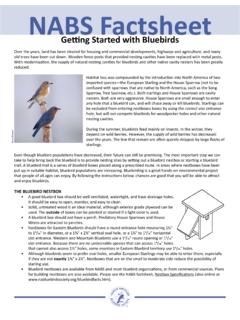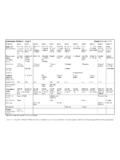Transcription of NBS actsheet - Bluebird
1 Monitoring Bluebird NestboxesWHY MONITOR YOUR NESTBOX?It is very important that Bluebird nestboxes be actively monitored (checked) at least once a week. Bluebirds are tolerant of humans, and will not abandon a nestbox that is properly monitored. All Bluebird boxes should be built so that they can be opened either from the side, front, or top. A box that is not monitored may do more harm to bluebirds than good. Monitoring increases the chances of success for bluebirds using the box. When good records are kept, it is also valuable for determining population trends.
2 Monitoring nestboxes will alert you to problems birds may be having with predators and competitors. House Sparrows (sometimes called English Sparrows) and European Starlings are non-native species introduced from Europe. Their aggressive seizure of cavity nest sites is a primary reason for declines in Bluebird populations. Starlings nest in many of the natural nest sites but can be excluded from nestboxes by using 1 or 1 inch entrance holes. House Sparrows are smaller, so they can readily enter Bluebird nestboxes. They frequently kill adult and nestling bluebirds, destroy their eggs, or drive them from their nests.
3 At no time should they be allowed to successfully nest in Bluebird boxes. Doing so will increase the House Sparrow population and further reduce the number of bluebirds. See the NABS factsheet on House Sparrow Control (available on our website at ).A paper wasp or mouse nest will drive nesting birds away from the box, and should be removed. Take appropriate precautions to avoid breathing the dust from a mouse what species is using the box is also beneficial. Bluebird societies would like you to monitor and report all species using your nestboxes, not just bluebirds.
4 Tree Swallows, titmice, chickadees, Carolina and House Wrens and nuthatches are all native, beneficial birds. Remember: It is illegal to remove an active nest of any native cavity-nesting bird. Keeping records on a weekly basis, and sending survey forms in at the end of the nesting season increases our knowledge of cavity-nesting any nesting effort has ended, either due to nest failure or successful fledging of the young, remove the used nest from the box. When a Bluebird nest is successful, re-nesting in the same box may be encouraged if the first nest is removed.
5 This can be done as soon as all chicks have left the nest. Females usually build a new TO MONITORWhen you monitor a box, determine which species is using it by examining nesting material and eggs. Record the date and the number of eggs or young observed. Knowing when the eggs were laid will help you determine if they are infertile, or when they should hatch and when the young would be expected to leave the nest. In the case of most cavity nesters, one egg is laid one each day until the entire clutch is complete. Incubation will then begin.
6 For bluebirds, incubation typically lasts approximately 12 14 days. After hatching, the chicks will remain in the nest for about 17 21 days. Your monitoring should be limited to viewing from a distance after the 12 13th day, or the chicks might jump or fly from the box KinneerNABS FactsheetBet ZimmermanMouse nestHOW TO MONITORNest monitoring should only be done during calm, mild, and dry weather conditions to reduce the chance of chilling chicks or eggs. Open the nestbox carefully, and do not to allow the eggs to fall out or chicks to jump out.
7 Songbirds have a poor sense of smell and will not abandon the nest due to monitoring the nest, eggs, or chicks. Even so, you should avoid touching eggs or monitoring as quickly and quietly as possible to minimize disturbance. Avoid disposing of used nest material near the nest site as it may attract predators instead put it in a paper or plastic bag and dispose of it in the trash far from the nestbox. Always be certain to close the box door securely before leaving. Record what you TO IDENTIFY NESTS AND EGGS BY SPECIESDay 0 Day 1 Day 2 Day 3 Day 7 Day 8 Day 9 Day 10 Day 14 Day 15 Day 16 Day 17 Day 4 Day 5 Day 6 Day 11 Day 12 Day 13 Day 18 Day 19 Day 20 All photos courtesy of Bet ZimmermanEastern Bluebird Daily GrowthBet ZimmermanBet ZimmermanMarion BallJim WilliamsBluebird: The 1 4 inch tall, relatively neat nest is built with fine grasses or pine needles with a fairly deep nest cup.
8 Eggs (4 6) are powder blue or occasionally white. Mountain and Western Bluebird nests may contain bits of trash or Gentry - USFWSE astern BluebirdsWestern BluebirdsMountain BluebirdsAlan & Elaine WilsonMarion BallMarion BallMarion BallMarion BallJim WilliamsTree and Violet-green Swallow: Their nest is also made of grasses but they may use somewhat coarser fibers than a Bluebird . It generally has a flatter cup than the Bluebird s and is usually lined with many feathers. Eggs (5 7) are white, pointy on one end, and smaller than those of a Wren: House Wrens fill a nestbox with sticks and then line the deep nest cup with fine plant fibers or feathers.
9 Dummy nests without the nest cup are often built in other cavities within the male House Wren s territory to reduce competition for resources. The tiny eggs (6 8) are glossy white/tan, heavily speckled with pinkish-brown : Chickadees build a nest of moss and plant down, with a small, deep nest cup lined with hair, fur or plant down. They lay 5 8 white or cream non-glossy, tiny eggs that are covered with reddish-brown speckles. Eggs are often covered with a plug of hair or fur when the female leaves the Sparrow: House Sparrows build a tall, sloppy nest of coarse grasses (usually with seed heads), often with feathers and pieces of scrap paper, cloth, cellophane, or other garbage.
10 The nest in a large box or in the open forms a canopy with a tunnel-like entrance. The 5 7 cream- or greenish-colored, non-glossy eggs have heavy brown markings. Bet ZimmermanBet ZimmermanDavid-MitchellMarion BallBet ZimmermanBet GargAdam KumiszczaTree SwallowsThe North American Bluebird Society, Inc. is a non-profit education, conservation, and research organization that promotes the recovery of bluebirds and other native cavity-nesting bird species in North nests sometimes found in Bluebird nestboxes (depending on the area)










